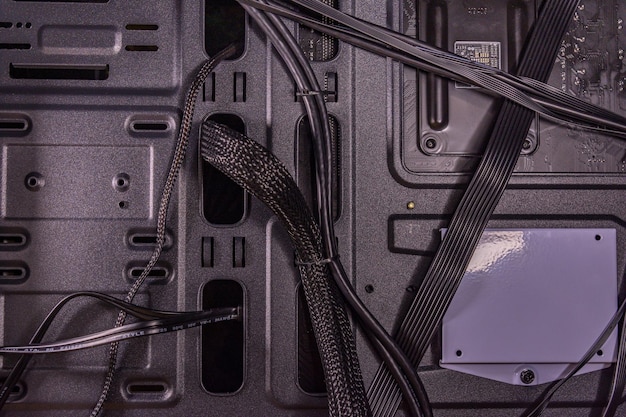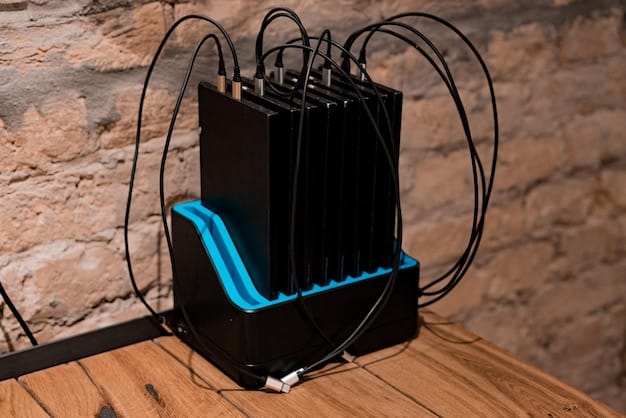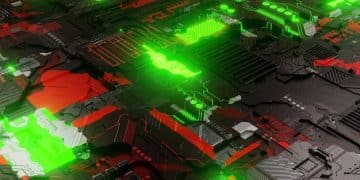The Ultimate Guide to Cable Management for a Clean Gaming PC Build

Effective cable management is essential for a clean, efficient gaming PC build, improving airflow, aesthetics, and overall system performance.
Building a gaming PC can be an exciting endeavor, but achieving a clean and organized build often hinges on effective cable management. This comprehensive guide provides the knowledge and techniques necessary to master cable management, ensuring optimal airflow, improved aesthetics, and enhanced overall system performance.
Why Cable Management Matters for Your Gaming PC
Proper cable management is more than just making your PC look good; it’s critical for performance and longevity. Messy cables can obstruct airflow, leading to higher temperatures and potential thermal throttling. Learn why investing time in cable management is a vital part of any serious gaming PC build.
Improved Airflow
Poorly managed cables can act as barriers, disrupting the smooth flow of air through your case. This can cause components such as the CPU and GPU to run hotter, reducing their lifespan and performance.
Enhanced Aesthetics
A clean build is a sign of a well-maintained and professional setup. Properly routed and hidden cables create a visually appealing interior, showcasing your components and lighting effects.
Easier Maintenance
When cables are neatly organized, diagnosing and replacing components becomes much simpler. You’ll spend less time untangling wires and more time enjoying your games.
Investing the time into cable management ensures both the longevity and optimal performance of your gaming rig. Keep reading to learn how to improve you gaming PC.

Planning Your Cable Management Strategy
Before you even start connecting cables, having a well-thought-out strategy is essential. Consider case layout, component placement, and cable routing options. A clear plan will save you time and headaches later on.
Assess Your Case and Components
Different cases offer various cable management features, such as routing holes, tie-down points, and hidden compartments. Understand the capabilities of your case and plan accordingly. Consider the length and type of cables required by your components.
Plan the Cable Paths
Visualize the most direct and efficient paths for each cable. This will minimize excess cable length and reduce clutter. Consider routing cables behind the motherboard tray or through designated channels.
Gather Necessary Supplies
Having the right tools and accessories on hand will make the process much smoother. Essential supplies include zip ties, Velcro straps, cable sleeves, and wire cutters.
- Zip Ties: Secure cables together and keep them in place.
- Velcro Straps: Reusable and adjustable ties for managing cables without causing damage.
- Cable Sleeves: Protective and decorative coverings for individual or groups of cables.
- Wire Cutters: For trimming excess zip tie length.
Effective planning is the foundation for successful cable management in your gaming PC. With a detailed strategy and the right tools, you’re well-equipped to create a clean and efficient setup.
Essential Cable Management Tools and Accessories
Having the right tools and accessories is crucial for effective cable management. From zip ties to cable sleeves, these items will help you organize and conceal your cables, resulting in a clean and professional-looking build. Let’s explore the essentials.
Zip Ties and Velcro Straps
Zip ties are inexpensive and effective for securing cables together. Velcro straps offer a reusable alternative, allowing for adjustments without cutting. These are useful for cables that may need occasional changes or adjustments. Consider using a combination of both to maximize their strengths.
Cable Sleeves and Extensions
Cable sleeves add a layer of protection and aesthetics to your cables. They come in various colors and materials, allowing you to customize the look of your build. Cable extensions can also be used to improve the reach and appearance of certain cables, especially those that are highly visible.
Routing Clips and Channels
Routing clips adhere to the inside of your case, providing anchor points for cables. Channels can be used to guide cables along specific paths, keeping them neatly organized. These accessories are particularly useful for managing cables in areas where space is limited.
- Adhesive Clips: Small clips that stick to the case to hold individual cables in place.
- Cable Combs: Organize and separate individual wires of a cable for a clean, parallel look.
- Modular Power Supply Cables: Use only the cables you need to reduce clutter.
With these tools, cable management will become much easier allowing you to create a seamless and perfect gaming PC.

Step-by-Step Guide to Cable Management
Now that you have a solid plan and the necessary tools, it’s time to start managing those cables. Follow this step-by-step guide to achieve a clean and efficient build, improving both the aesthetics and performance of your gaming PC.
Install Components Strategically
Start by installing components in an order that facilitates cable management. For example, mount the motherboard first, followed by the power supply. This allows you to route cables more easily.
Route Cables Behind the Motherboard Tray
Most cases have designated routing holes and channels behind the motherboard tray. Use these to conceal the bulk of your cables, keeping the main compartment clutter-free.
Use Tie-Down Points and Anchors
Secure cables using zip ties or Velcro straps at various tie-down points within the case. This will prevent cables from dangling and obstructing airflow. Adhere cables in place for maximum cable management.
- Group Similar Cables: Bundle cables that serve the same component together for tidiness.
- Manage Excess Length: Neatly fold or loop excess cable length and secure it out of sight.
- Regularly Check and Adjust: Ensure cables are not strained or obstructing any components.
With time, dedication, and patience your gaming PC will be the envy of all your friends.
Advanced Cable Management Techniques
For those looking to take their cable management to the next level, these advanced techniques will help you achieve an even cleaner and more professional-looking build. Explore custom sleeving, hidden compartments, and other advanced strategies.
Custom Cable Sleeving
Custom sleeving involves replacing the stock cables with individually sleeved cables. This allows for greater customization and a cleaner aesthetic. It can be more expensive, but the visual impact is significant.
Utilize Hidden Compartments
Some cases have hidden compartments or panels that can be used to conceal excess cables or components. Take advantage of these features to further declutter the main compartment.
Plan for Future Upgrades
When routing cables, consider potential future upgrades. Leave enough slack in the cables to accommodate new components or adjustments.
These techniques are sure to make any PC Builder proud, allowing you to enjoy more time gaming with less worries about PC health.
Maintaining Your Cable Management Over Time
Cable management isn’t a one-time task; it’s an ongoing process. Regular maintenance is essential to ensure your cables remain organized and your system performs optimally. Learn how to inspect, clean, and adjust your cable management system over time.
Regular Inspections
Periodically inspect your cables to ensure they are still properly routed and secured. Check for any signs of wear or damage. This helps to address problems early before they escalate.
Dust Removal
Dust can accumulate on cables and components, reducing airflow and increasing temperatures. Regularly clean your system with compressed air to remove dust and maintain optimal performance.
Adjustments and Upgrades
Whenever you add or remove components, take the opportunity to reassess your cable management. Make any necessary adjustments to accommodate the new setup.
A computer build takes time and maintaining it is key to continued successful gaming for years to come!
| Key Point | Brief Description |
|---|---|
| 💨 Improved Airflow | Optimizing cable paths ensures better airflow, reducing component temperatures. |
| ✨ Enhanced Aesthetics | Neatly managed cables create a visually appealing, professional-looking build. |
| 🛠️ Easier Maintenance | Organized cables simplify component upgrades and troubleshooting. |
| 🧰 Essential Tools | Zip ties, velcro straps, and cable sleeves are key for effective organization. |
Frequently Asked Questions
▼
Good cable management improves airflow, lowers component temperatures, enhances the aesthetic appeal of your build, and makes future upgrades and maintenance easier.
▼
Essential tools include zip ties, Velcro straps, cable sleeves, wire cutters, and adhesive cable clips. These tools help you organize and secure your cables effectively.
▼
You should inspect your cables regularly, at least every few months, to ensure they are still properly routed and secured. Clean dust and make adjustments as needed.
▼
Cable sleeving involves covering individual cables with decorative sleeves. This not only protects the cables but also allows for greater customization and a cleaner aesthetic.
▼
Yes, poor cable management can obstruct airflow, leading to higher component temperatures. This can cause thermal throttling, reducing the performance and lifespan of your components.
Conclusion
Mastering cable management is an essential skill for any PC builder, enhancing both the performance and aesthetics of your gaming rig. By planning, using the right tools, and maintaining your cable management over time, you can create a clean, efficient, and visually stunning build that will impress for years to come.





